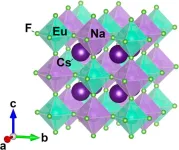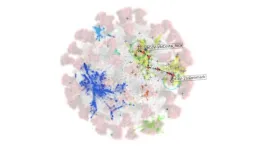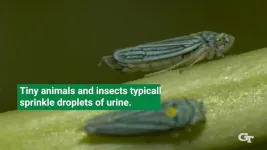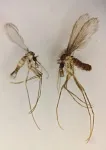Oncotarget at AACR Annual Meeting 2024
2024-03-11
(Press-News.org)
BUFFALO, NY- March 11, 2024 – Impact Journals publishes scholarly journals in the biomedical sciences with a focus on all areas of cancer and aging research. Oncotarget is one of the most prominent journals published by Impact Journals.
Impact Journals will be participating as an exhibitor at the American Association for Cancer Research (AACR) Annual Meeting 2024 from April 5-10 at the San Diego Convention Center in San Diego, California. This year, the AACR meeting theme is “Inspiring Science • Fueling Progress • Revolutionizing Care.”
Visit booth #4159 at the AACR Annual Meeting 2024 to connect with members of the Oncotarget team.
About Oncotarget: Oncotarget (a primarily oncology-focused, peer-reviewed, open access journal) aims to maximize research impact through insightful peer-review; eliminate borders between specialties by linking different fields of oncology, cancer research and biomedical sciences; and foster application of basic and clinical science.
Oncotarget is indexed and archived by PubMed/Medline, PubMed Central, Scopus, EMBASE, META (Chan Zuckerberg Initiative) (2018-2022), and Dimensions (Digital Science).
To learn more about Oncotarget, visit Oncotarget.com and connect with us on social media:
X, formerly Twitter
Facebook
YouTube
Instagram
LinkedIn
Pinterest
Reddit
Spotify, and available wherever you listen to podcasts
Click here to subscribe to Oncotarget publication updates.
For media inquiries, please contact media@impactjournals.com.
END
[Attachments] See images for this press release:

ELSE PRESS RELEASES FROM THIS DATE:
2024-03-11
Embargoed for release until 5:00 p.m. ET on Monday 11 March 2024
Annals of Internal Medicine Tip Sheet
@Annalsofim
Below please find summaries of new articles that will be published in the next issue of Annals of Internal Medicine. The summaries are not intended to substitute for the full articles as a source of information. This information is under strict embargo and by taking it into possession, media representatives are committing to the terms of the embargo not only on their own behalf, but also ...
2024-03-11
In the quest to develop quantum computers and networks, there are many components that are fundamentally different than those used today. Like a modern computer, each of these components has different constraints. However, it is currently unclear what materials can be used to construct those components for the transmission and storage of quantum information.
In new research published in the Journal of the American Chemical Society, University of Illinois Urbana Champaign materials science & engineering professor Daniel Shoemaker and graduate student Zachary Riedel ...
2024-03-11
BOSTON – In the largest randomized clinical trial and first of its kind to date in the United States, a team led by investigators at Beth Israel Deaconess Medical Center (BIDMC) assessed the efficacy and safety of using a drug-coated balloon in patients undergoing coronary angioplasty. In an original investigation presented at the Cardiology Research Technology conference in Washington, D.C. and published simultaneously in JAMA, the team reports that patients treated with a balloon coated with paclitaxel, a drug to prevent restenosis, experienced lower rates of failure compared with patients treated with an uncoated balloon.
The findings of the trial—which ...
2024-03-11
Some cancerous tumors hijack proteins that act as “brakes” on our immune system and use them to form a sort of shield against immune recognition. Immunotherapy treatments have been created that turn off these “brakes” and allow our body to attack foreign-looking cancer cells. To further advance such treatments, researchers at Stanford University and New York University have published a new structure of one of these brake proteins, LAG-3. Their work contains key details of the molecule’s structure, as well as information about how the LAG-3 protein functions.
Although over a dozen immunotherapies targeting LAG-3 are in development, and one is already FDA approved, ...
2024-03-11
Scientists at The Universities of Manchester and Oxford have developed an AI framework that can identify and track new and concerning COVID-19 variants and could help with other infections in the future.
The framework combines dimension reduction techniques and a new explainable clustering algorithm called CLASSIX, developed by mathematicians at The University of Manchester. This enables the quick identification of groups of viral genomes that might present a risk in the future from huge volumes of data.
The study, presented this week ...
2024-03-11
Cicadas are the soundtrack of summer, but their pee is more special than their music. Rather than sprinkling droplets, they emit jets of urine from their small frames. For years, Georgia Tech researchers have wanted to understand the cicada’s unique urination.
Saad Bhamla, an assistant professor in the School of Chemical and Biochemical Engineering, and his research group hoped for an opportunity to study a cicada’s fluid excretion. However, while cicadas are easily heard, they hide in trees, making them hard to observe. As such, seeing a cicada pee is an event. Bhamla’s team had only watched the process on YouTube.
Then, ...
2024-03-11
Scientists have discovered the specific enzyme that a species of sandfly uses to produce a pheromone attractant, which could lead to the creation of targeted traps to control them and reduce the spread of the potentially fatal disease, Leishmaniasis.
The team from the University of Nottingham’s School of Chemistry analysed the genome of the Lutzomyia longipalpis, a species of sandfly native to Brazil and South America that can spread a disease called Leishmaniasis.
The study identified the enzyme, called a Terpene Synthase that is responsible ...
2024-03-11
CAMBRIDGE, MA -- MIT chemists have designed a sensor that detects tiny quantities of perfluoroalkyl and polyfluoroalkyl substances (PFAS) — chemicals found in food packaging, nonstick cookware, and many other consumer products.
These compounds, also known as “forever chemicals” because they do not break down naturally, have been linked to a variety of harmful health effects, including cancer, reproductive problems, and disruption of the immune and endocrine systems.
Using the new sensor technology, the researchers showed that they could detect PFAS levels as low as 200 parts per trillion in a water sample. The device they designed could offer a way ...
2024-03-11
The perception of softness can be taken for granted, but it plays a crucial role in many actions and interactions – from judging the ripeness of an avocado to conducting a medical exam, or holding the hand of a loved one. But understanding and reproducing softness perception is challenging, because it involves so many sensory and cognitive processes.
Robotics researchers have tried to address this challenge with haptic devices, but previous attempts have not distinguished between two primary elements of softness perception: cutaneous cues (sensory feedback ...
2024-03-11
Mycobacterium tuberculosis (Mtb), the bacteria that causes a tuberculosis infection, is present in exhaled breath of 90% of those presenting with suspected tuberculosis. This includes those who were negative on conventional sputum testing and not diagnosed with TB. This raises the possibility that those who have tested negative may be unknowingly transmitting the infection. Researchers from the University of Cape Town and Amsterdam UMC analysed results from over 100 patients who presented themselves to clinics in South Africa. These findings are published today in PNAS.
“If ...
LAST 30 PRESS RELEASES:
[Press-News.org] Oncotarget at AACR Annual Meeting 2024





